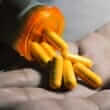Background
- 1,4-Butanediol is a colorless, thick liquid that is converted into gamma-hydroxybutyrate (GHB) after ingestion. GHB is a strong sedative that is often used as a date-rape drug because it is easily concealed in water due to a lack of smell and taste.
- GHB is a metabolite of gamma-aminobutyric acid (GABA), an inhibitory neurotransmitter, and has been linked to cases of dependence, coma, and death. GBL (gamma-butyrolactone), a solvent commonly used as a paint stripper, is another precursor for GHB. 1,4-Butanediol itself is used as an industrial chemical to make some plastics and fibers.
- GHB, GBL, and 1,4-butanediol are prevalent drugs of abuse in the United States. While available as a prescription drug for sleep disorders in some other countries, GHB was banned in the United States by the U.S. Food and Drug Administration (FDA) in 1990 because of the dangers associated with its use. It has since been approved only for the treatment of a rare form of narcolepsy (a sleep disorder that result in excessive daytime sleepiness). In Europe, GHB has been used as an anesthetic and experimentally to treat alcohol withdrawal.
References
- Caputo, F., Addolorato, G., Stoppo, M., Francini, S., Vignoli, T., Lorenzini, F., Del Re, A., Comaschi, C., Andreone, P., Trevisani, F., Bernardi, M., and Alcohol Treatment Study Group. Comparing and combining gamma-hydroxybutyric acid (GHB) and naltrexone in maintaining abstinence from alcohol: an open randomised comparative study. Eur.Neuropsychopharmacol. 2007;17(12):781-789.
View Abstract - Caputo, F., Vignoli, T., Lorenzini, F., Ciuffoli, E., Del Re, A., Stefanini, G. F., Addolorato, G., Trevisani, F., and Bernardi, M. Suppression of craving for gamma-hydroxybutyric acid by naltrexone administration: three case reports. Clin.Neuropharmacol. 2005;28(2):87-89.
View Abstract - Dyer, JE. Evolving abuse of GHB in California: bodybuilding drug to date-rape drug. J Toxicol Clin Toxicol 2000;38:184.
- Gervasi, N., Monnier, Z., Vincent, P., Paupardin-Tritsch, D., Hughes, S. W., Crunelli, V., and Leresche, N. Pathway-specific action of gamma-hydroxybutyric acid in sensory thalamus and its relevance to absence seizures. J Neurosci. 12-10-2003;23(36):11469-11478.
View Abstract - Gunja, N., Doyle, E., Carpenter, K., Chan, O. T., Gilmore, S., Browne, G., and Graudins, A. Gamma-hydroxybutyrate poisoning from toy beads. Med J Aust. 1-7-2008;188(1):54-55.
View Abstract - Harrington, R. D., Woodward, J. A., Hooton, T. M., and Horn, J. R. Life-threatening interactions between HIV-1 protease inhibitors and the illicit drugs MDMA and gamma-hydroxybutyrate. Arch Intern.Med 10-11-1999;159(18):2221-2224.
View Abstract - Irwin, R. D. A review of evidence leading to the prediction that 1,4-butanediol is not a carcinogen. J Appl.Toxicol. 2006;26(1):72-80.
View Abstract - Maldonado, C., Rodriiuez-Arias, M., Aguilar, M. A., and Minarro, J. GHB differentially affects morphine actions on motor activity and social behaviours in male mice. Pharmacol Biochem.Behav. 2003;76(2):259-265.
View Abstract - Navarro, J. F., Davila, G., Pedraza, C., and Arias, J. L. Anxiogenic-like effects of gamma-hydroxybutyric acid (GHB) in mice tested in the light-dark box. Psicothema. 2008;20(3):460-464.
View Abstract - Ricaurte, G. A. and McCann, U. D. Recognition and management of complications of new recreational drug use. Lancet 6-18-2005;365(9477):2137-2145.
View Abstract - Shannon, M. and Quang, L. S. Gamma-hydroxybutyrate, gamma-butyrolactone, and 1,4-butanediol: a case report and review of the literature. Pediatr.Emerg.Care 2000;16(6):435-440.
View Abstract - Tarabar, A. F. and Nelson, L. S. The gamma-hydroxybutyrate withdrawal syndrome. Toxicol.Rev. 2004;23(1):45-49.
View Abstract - Thai, D., Dyer, J. E., Jacob, P., and Haller, C. A. Clinical pharmacology of 1,4-butanediol and gamma-hydroxybutyrate after oral 1,4-butanediol administration to healthy volunteers. Clin.Pharmacol Ther. 2007;81(2):178-184.
View Abstract - van Nieuwenhuijzen, P. S. and McGregor, I. S. Sedative and hypothermic effects of gamma-hydroxybutyrate (GHB) in rats alone and in combination with other drugs: assessment using biotelemetry. Drug Alcohol Depend. 8-1-2009;103(3):137-147.
View Abstract - Zvosec, D. L., Smith, S. W., McCutcheon, J. R., Spillane, J., Hall, B. J., and Peacock, E. A. Adverse events, including death, associated with the use of 1,4-butanediol. N.Engl.J.Med. 1-11-2001;344(2):87-94.
View Abstract







